Frey's Syndrome Consequent to an Unusual Pattern of Temporomandibular Joint Dislocation: Case Report with Review of Its Incidence and Etiology
- PMID: 24436729
- PMCID: PMC3699238
- DOI: 10.1055/s-0032-1332210
Frey's Syndrome Consequent to an Unusual Pattern of Temporomandibular Joint Dislocation: Case Report with Review of Its Incidence and Etiology
Abstract
Frey's syndrome was first described in the 18(th) century. Recognizing it as a nonspecific condition, the symptom of gustatory sweating in patients with parotid gland inflammation was described by Duphenix and Baillarger. However, as a specific diagnostic entity, gustatory sweating, following trauma to parotid glands, was first described by Polish neurologist Lucie Frey, in 1923, and hence he proposed the term auriculotemporal syndrome. The condition is characterized by sweating, flushing, a sense of warmth, and occasional pain in the preauricular and temporal areas, following the production of a strong salivary stimulus. Several etiologies of Frey's syndrome have been mentioned in the literature; however, none attribute dislocation of the "intact" mandibular condyle as a cause of the syndrome. Reviewing its pathophysiology, etiology, and incidence in detail, we describe a case of Frey's syndrome subsequent to superolateral dislocation of the intact mandibular condyle following fracture of the anterior mandible. Its management and prevention are also discussed in brief.
Keywords: Frey's syndrome; Minor's test; mandibular condyle; superolateral dislocation.
Figures


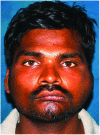

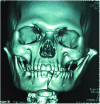
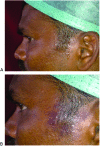

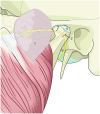
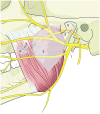
Similar articles
-
Frey's syndrome after condylar fracture: case report.Braz Dent J. 2004;15(2):159-62. doi: 10.1590/s0103-64402004000200014. Epub 2005 Mar 11. Braz Dent J. 2004. PMID: 15776201
-
Graft interposition for preventing Frey's syndrome in patients undergoing parotidectomy.Cochrane Database Syst Rev. 2019 Oct 3;10(10):CD012323. doi: 10.1002/14651858.CD012323.pub2. Cochrane Database Syst Rev. 2019. PMID: 31578708 Free PMC article. Review.
-
Application of medical thermography to the diagnosis of Frey's syndrome.Head Neck. 1997 Mar;19(2):143-7. doi: 10.1002/(sici)1097-0347(199703)19:2<143::aid-hed10>3.0.co;2-e. Head Neck. 1997. PMID: 9059873
-
Treatment of Frey's syndrome with botulinum toxin.J Med Assoc Thai. 2007 Nov;90(11):2397-402. J Med Assoc Thai. 2007. PMID: 18181326
-
Frey's Syndrome: A Review of Aetiology and Treatment.Cureus. 2021 Dec 2;13(12):e20107. doi: 10.7759/cureus.20107. eCollection 2021 Dec. Cureus. 2021. PMID: 34873562 Free PMC article. Review.
Cited by
-
Frey's syndrome: A review of the physiology and possible role of neurotrophic factors.Laryngoscope Investig Otolaryngol. 2021 Apr 8;6(3):420-424. doi: 10.1002/lio2.559. eCollection 2021 Jun. Laryngoscope Investig Otolaryngol. 2021. PMID: 34195362 Free PMC article.
References
-
- Duphenix M. Observations sur les fistules du canal salivaire de Stenon. I. Sur une playe compliquee a la joue ou le canal salivaire fut dechire. Mem Acad Royal Chir. 1757;3:431–437.
-
- Baillarger J GF. Mémoire sur l'oblitération du canal de Stenon. Gaz Med. 1853;23:194.
-
- Weber F. A case of localized sweating and blushing on eating, possibly due to temporary compression of vasomotor fibres. Trans Clin Soc. 1897;31:277–280.
-
- Frey L. Le syndrome du nerve auriculo-temporal. Rev Neurol. 1923;2:97–104.
-
- Manson M, David K. Auriculotemporal syndrome (Frey's syndrome) following surgery of parotid tumors. Am J Surg. 1961;102:777–780. - PubMed
Publication types
LinkOut - more resources
Full Text Sources
Other Literature Sources
